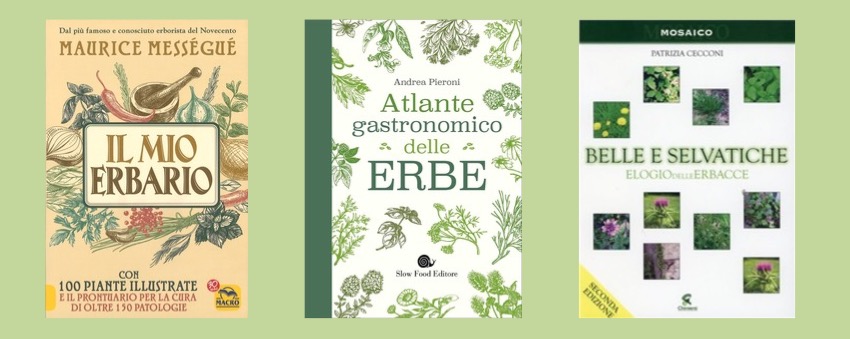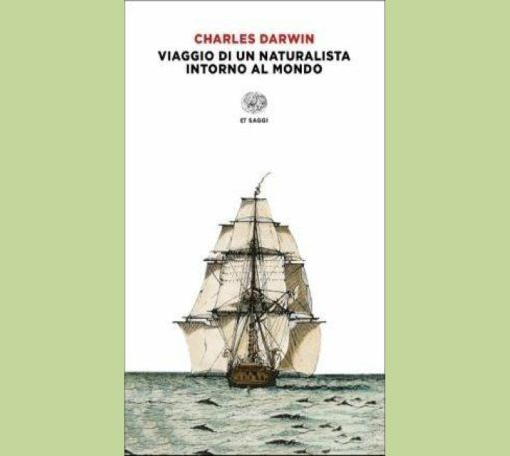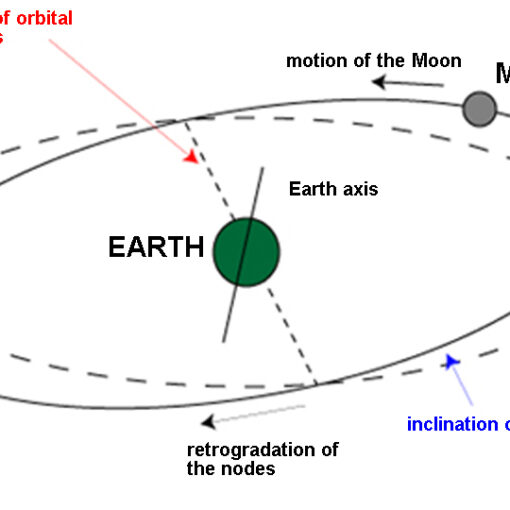It’s a warm day at the end of February, and one of the builders that are renovating some parts of the house warns: “In an hour or so we have to work on the external side of the house facing south; shall we dissemble the lamp or do you prefer to do it yourself?”
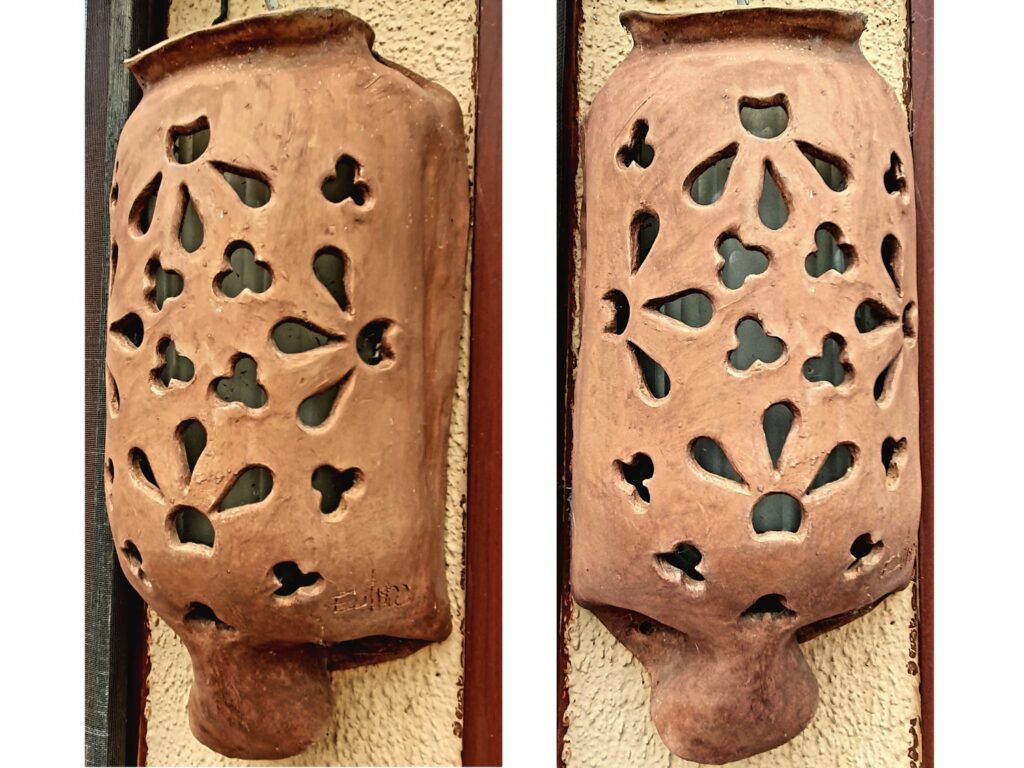
My husband and I decide to dissemble it ourselves, so we also take the opportunity to give it a clean: let’s hold a screwdriver and be careful because it is made of terracotta. He unscrews it, I hold it so it doesn’t fall. Once the screws are removed, there is a little resistance. I pull lightly and it sounds like a slight crackle, like microscopic bonds breaking.
The amazement that follows is contagious. We are both speechless. From the outside, looking from all sides, you couldn’t see anything… and it’s been just over a year since the last time our housekeeper cleaned it. Her phrase comes to mind: “You have no idea what I found inside!
That’s true! An ecosystem has been created in the gap between the lamp and the lamp cover!”
And I am reminded of Professor Nobili who, in the first year of biological sciences, during the general biology course, explained to us that a vacuum does not exist in nature.
So, equipped with a lens and a camera, and intrigued, we look closely at this little world that has developed, without our knowledge, in this very narrow space.
To begin with, we examine the space occupied by this microenvironment: the terracotta covering, a natural material, protects from excessive heat and cold; ventilation is guaranteed by the holes through which light passes and the material is extremely breathable.
The wall on which the lamp rests is exposed to the south: in winter it protects eggs and larvae which will hatch and flutter in spring; in summer the leaves of the grape pergola protect it from excessive heat.
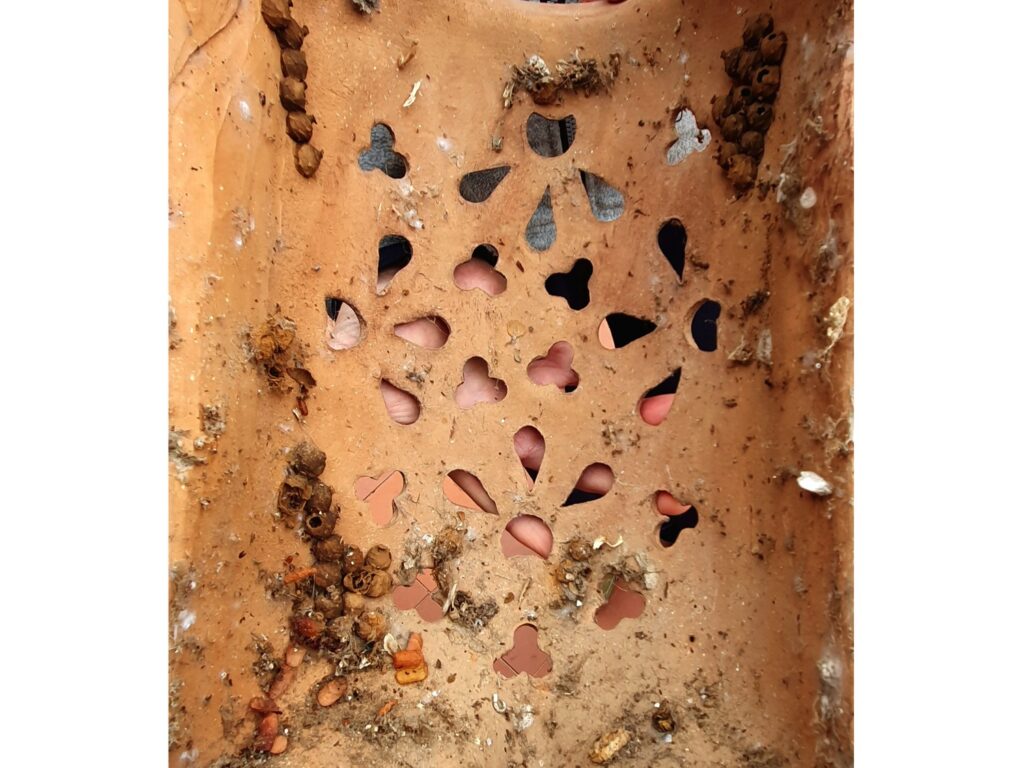
Looking at the inside of the lamp cover, we notice how its porous surface allowed the potter wasps to anchor their small jars on the wall of the lamp cover. There are different species of wasps capable of “working” the mud; we think that the potter wasp that built these vases is the Eumenes fraternus. It is a species with solitary behavior native to the eastern United States and Canada: the female builds a miniature pot with mud, in which she lays an egg and a live caterpillar paralyzed by her venom. The small larva that will be born from the egg will be able to develop by feeding on the caterpillar until the new wasp comes out of the pot.
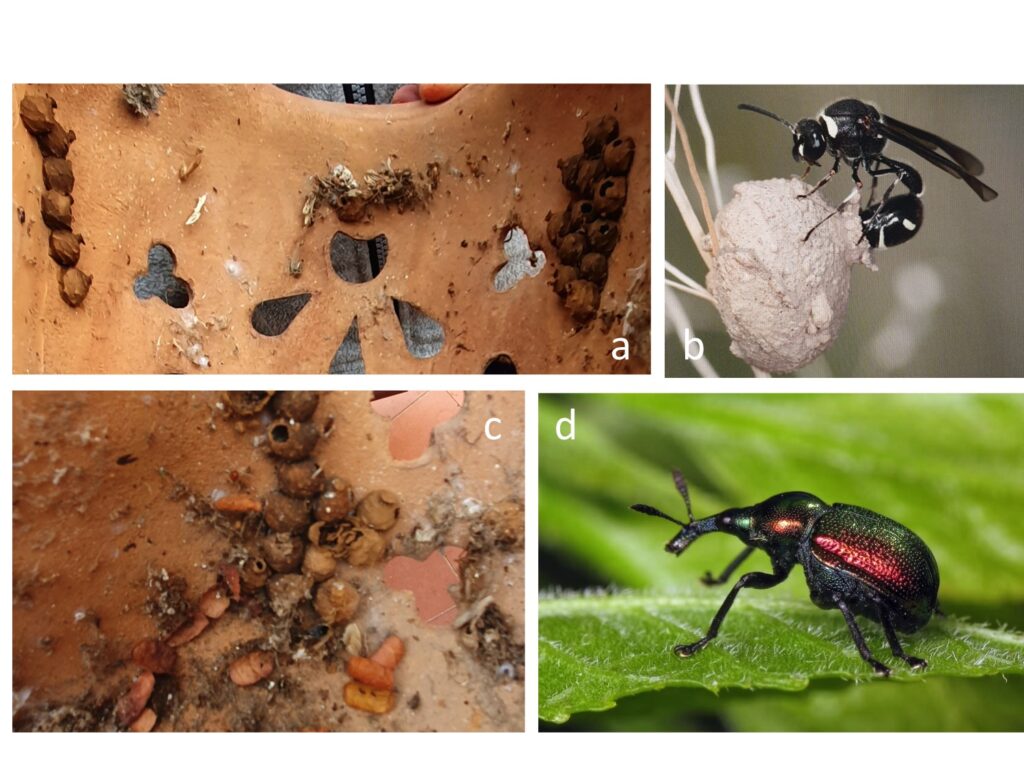
a. Potter wasp (Eumenes fraternus) nests; b. a female has just finished building the vase that will house one of her eggs; c. small, mysterious fragments of poplar leaf “cigars” scattered among last year’s wasp pots; d. poplar cigar bush (Byctiscus populi).
In the lower part of the lamp cover, among the old wasp vases, we see fragments of rolled-up dry poplar leaves. Last summer we noticed some rolled leaves on a high branch of a poplar and, searching in entomology manuals, we discovered that one of our poplars was home to the poplar cigar bush (Byctiscus populi). Seeing pieces of these “cigars” in the lamp cover leaves us very, very perplexed. The poplars are less than ten meters from the lamp, but the cigar fragments cannot have arrived here on their own…
The eggs of the poplar cigar maker are laid inside “cigars” obtained by rolling up the edge of a single leaf; the operation is facilitated by cutting the leaf stalk or shoot in order to reduce its firmness, without causing it to dry out. Each cigar can contain up to ten eggs. The young larvae feed on the leaf tissues inside the cigar which soon falls to the ground. The larvae reach maturity during the summer and abandon the cigar to build a pupation cell in the ground. The new adults can remain in the cell until the following spring, or emerge in the autumn and survive the winter in makeshift shelters.
Knowing all this, the question that arises spontaneously is: how did those pieces of cigar get into the lamp cover? Could it have been the potter wasp that took the small larvae of the cigar wasp to feed its larvae and could it have also happened it took the small pieces of rolled leaves with it?
We will never know!
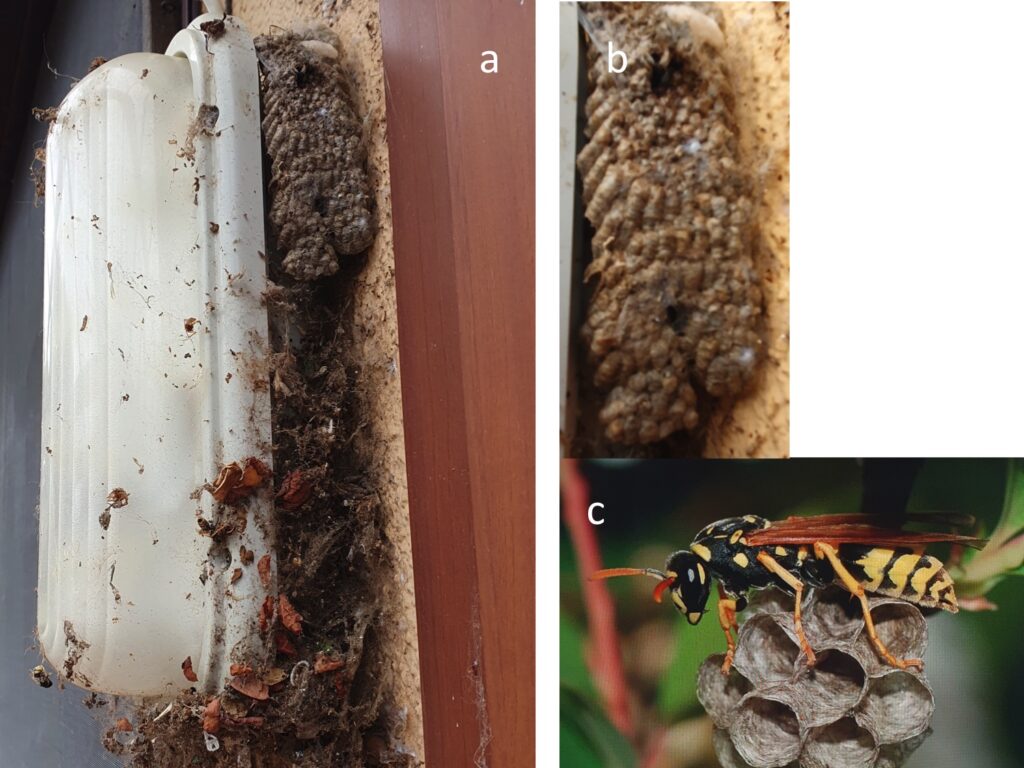
a. Right side of the lamp, above a nest of paper wasps (Polistes dominula) seen from the bottom; below you can see a dead and now faded centipede; b. enlargement of the paper wasp nest; c. young queen of Polistes dominula intent on building the first cells of the nest.
Looking at the right side of the lamp, we see how the paper wasps have built a nest in the gap between the wall and the lamp, placing it on the lamp cover. To build their nests, these social wasps use paper that they make from wood pulp, just like we do. They use their strong jaws to scrape the wood of trees or other artifacts, then knead it with saliva and turn it into cardboard.
Polistes dominula belongs to the group of paper wasps that live in colonies founded by a progenitor queen. The fertile queen escapes the rigors of winter by sheltering in warm, dry places, and at the beginning of April, she wakes up and founds the colony. She locates a sheltered place, then collects pieces of bark from the trees and begins to build the first nucleus of the nest. Once the first cells have been built, the queen lays an egg in each of them; upon hatching she provides for the maintenance of the larvae until their metamorphosis into adult wasps: they will become the worker caste. The new workforce will enlarge the nest, procure food, and defend the colony; the queen will instead continue her work as an ovipositor. Generally, over time, the colony takes on the appearance of a silvery-grey rosette; in our case, having to adapt to the available spaces, it developed vertically. The life of the colony ends as autumn approaches: the fertilized females will survive the winter by sheltering from the cold, while the rest of the colony will perish. In the case of our nest, we notice how the apical part of the cells is arranged towards a space very sheltered from the scorching summer sun. This arrangement likely saved the colony the energy it is generally forced to expend to create a flow of refrigerated air by rapidly vibrating its wings.
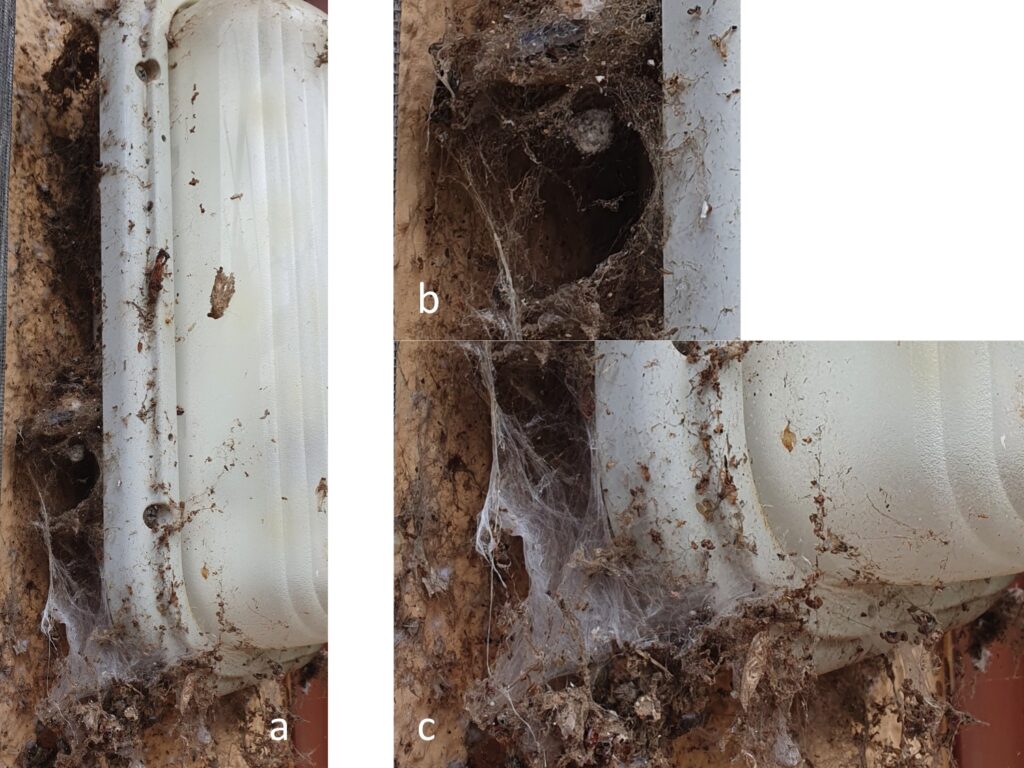
a. left side of the lamp; b. funnel (or tubular) spider web; c. tangled (or irregular) web.
The gap between the wall and the left side of the lamp is dominated by spiders. The upper part is occupied by a funnel-shaped (or tubular) web typical of spiders belonging to the families Segestriidae, which use them for protection and signaling, and Amaruobiidae, which use them for protection and capture. In both cases the web has the function of protection and refuge: the spider uses the “funnel” to hide and consume its prey. In the case of segestriids, the spider lurks inside and is called out when an insect vibrates one of the threads that support the web, alerting it to its presence. The spider captures and immobilizes the insect and brings it inside to eat it. In the case of amaruobiids, the web is constructed in such a way as to retain the insect with a sort of “velcro effect”. Also in this case the unfortunate insect will be taken into the “funnel” and devoured.
The tangled (or irregular) web serves almost exclusively to capture prey. The spiders belonging to the Theridiidae family build it with viscous threads in which the victims become entangled, while the Dictynidae build it with the “velcro effect” and use it both to capture prey and to protect themselves.
As evidence of the lavish meals made by the creators of the spider webs, we found dozens of “leftovers” belonging to moths, flies, dragonflies, and elytra of insects of different colors.
We also think that many of these prey and perhaps the oothecae that housed the small spiders were used by the paper wasp workers to feed the ravenous colony.
All corners of the Earth, even the most remote, are home to “living things” that organize themselves into small or large ecosystems. And if we say large or small, we are only referring to the dimensions they occupy, but not to their complexity.
Thanks
A special thanks to Maria Beatrice Lupi for suggesting the very perfect title of the article.
Credits
Author: Anna Lacci is a scientific popularizer and expert in environmental education and sustainability and in territory teaching. She is the author of documentaries and naturalistic books, notebooks and interdisciplinary teaching aids, and multimedia information materials.
Translation by Maria Antonietta Sessa

